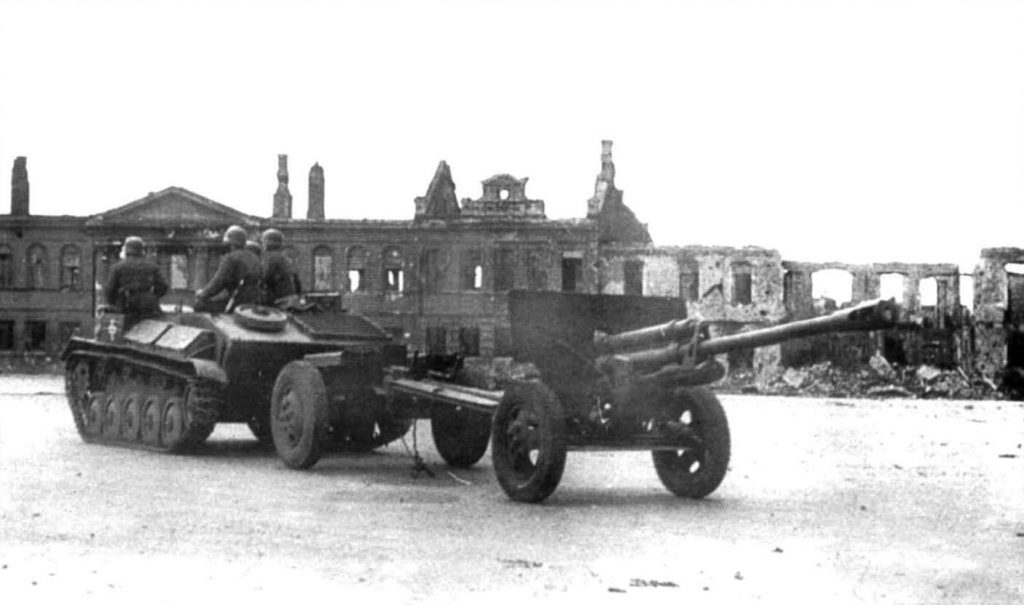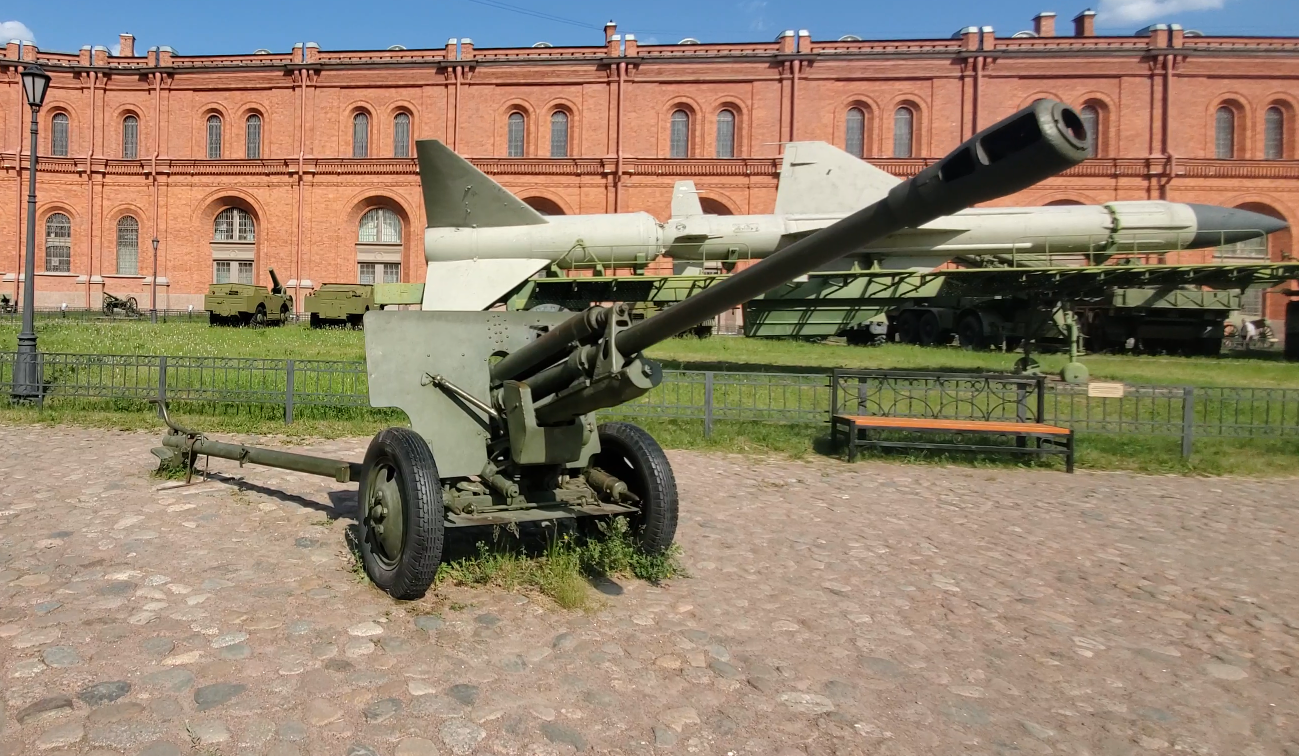ZIS3 – 76-mm divisional gun. M1942 ZiS-3 became the most produced Soviet artillery gun during WW2.
For it’s simplicity, low weight and good fighting qualities, it was one of the best weapons of the Second World War. In the post-war period, the ZiS-3 was in service with the Soviet Army for a long time., and was also actively exported to a number of countries, in some of which it was in service for 2016, and is probably in service at the present time.
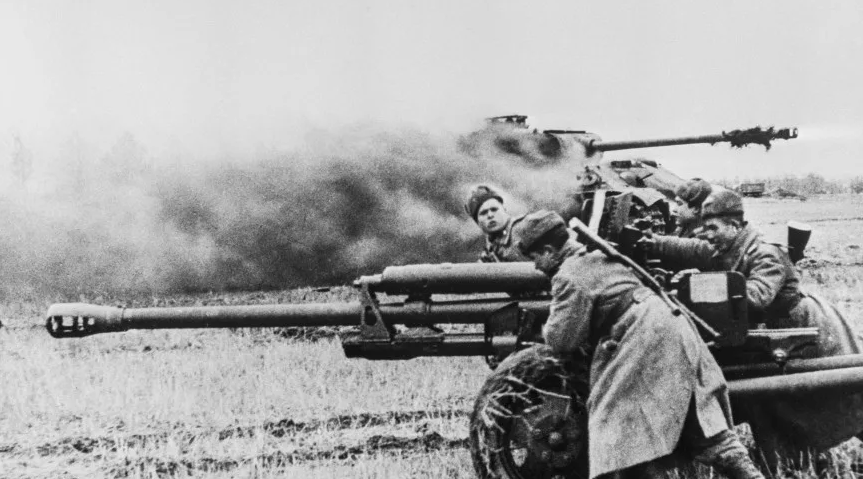
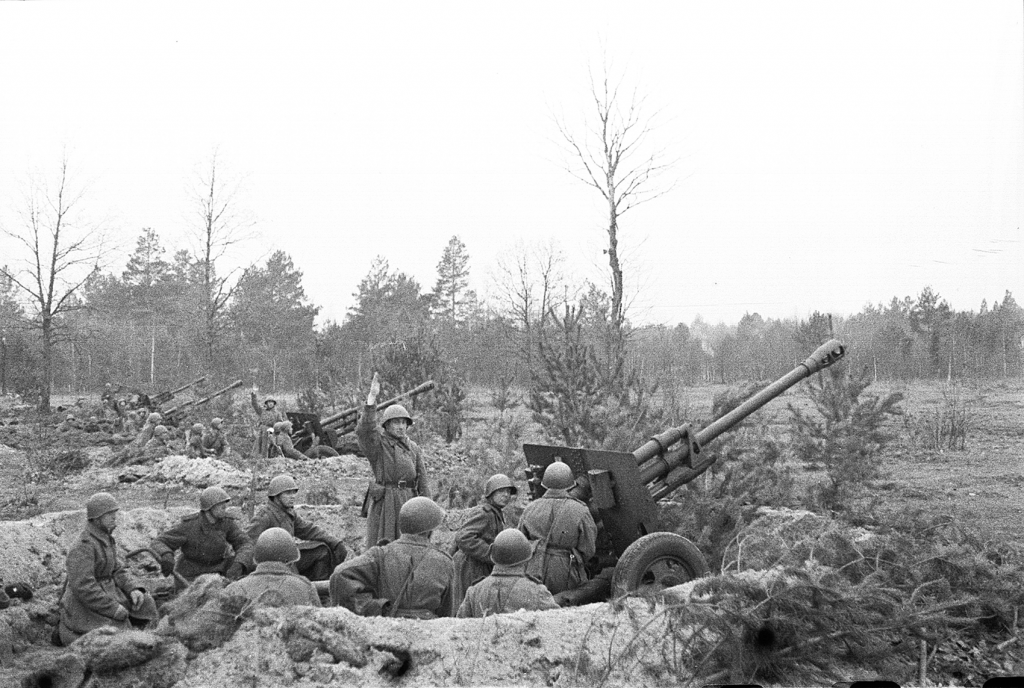
History and creation
The development of the gun began in May 1941 at the initiative of V.G. Grabin. At that time, an anti-tank gun of this caliber was superfluous, since Germany (with which war was expected) did not have heavy tanks, while divisional guns of caliber 85-95 mm had a higher power of high-explosive fragmentation ammunition.
Structurally, the ZiS-3 is a superstructure of the swinging part of the previous model of the F-22USV divisional gun on the light carriage of the 57-mm ZiS-2 anti-tank gun. The significant recoil force was compensated for by a muzzle brake, which was absent in the F-22USV. Also on the ZiS-3, an important drawback of the F-22USV was eliminated. – placement of aiming handles on different sides of the gun barrel. This allowed the crew numbers of four people (commander, gunner, loader, carrier) to perform only their functions. However, after successful factory tests, the prototype of the gun was hidden from prying eyes. The design of the new weapon was carried out in close cooperation with technologists, the design itself was immediately created for mass production.
Operations were simplified and reduced (in particular, high-quality casting of large parts was actively introduced), technological equipment and requirements for the machine tool park were thought out, requirements for materials were reduced, their savings were introduced, unification and in-line production of units were envisaged. All this made it possible to obtain a weapon that was almost three times cheaper than the F-22USV., while no less effective.
The unsuccessful, if not catastrophic, start of the Great Patriotic War caused heavy losses of the available artillery. In the battles of 1941, the ZiS-3 showed its advantage over the heavy and inconvenient ‘F-22 USV’. As a result, this allowed V.G. Grabin to present the ZiS-3 personally to I.V. Stalin and to obtain official permission for the production of weapons, which by that time had already been produced by the plant and was actively used in the army. At the beginning of February 1942, official tests were carried out, which were rather a formality and lasted only five days. According to their results, the ZiS-3 was put into service on February 12, 1942 with the official name “76-mm divisional gun mod. 1942 “. It entered the army in several modifications. ZiS-3 – the world’s first artillery gun, which was assembled on an assembly line and the most massively produced gun of the Great Patriotic War – in total, almost 48.5 thousand pieces were produced from 1941 to 1945 (about 14,500 more guns were mounted on the SU-76 ACS). For comparison, during the same period of time, the industry of Nazi Germany produced about 25,000 towed 75-mm Pak 40 anti-tank guns and about 2,600 various self-propelled guns armed with them, which in the Wehrmacht were analogous to the ZiS-3 for their intended purpose.
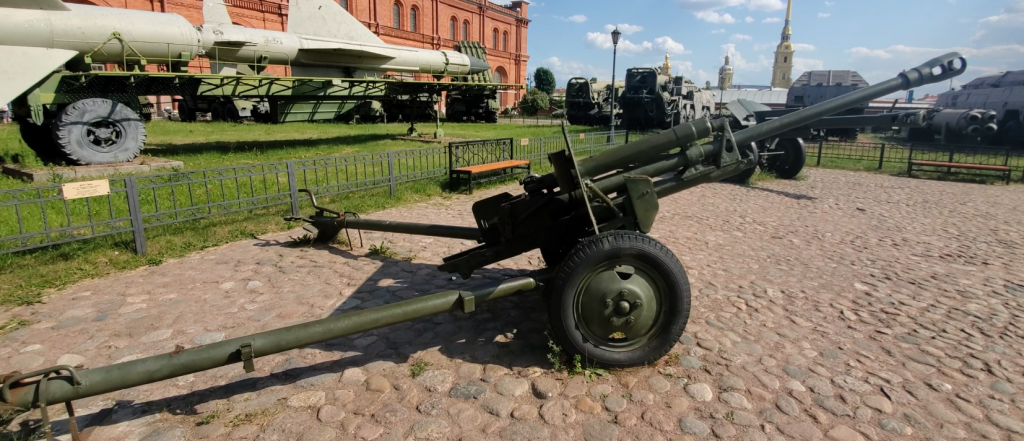
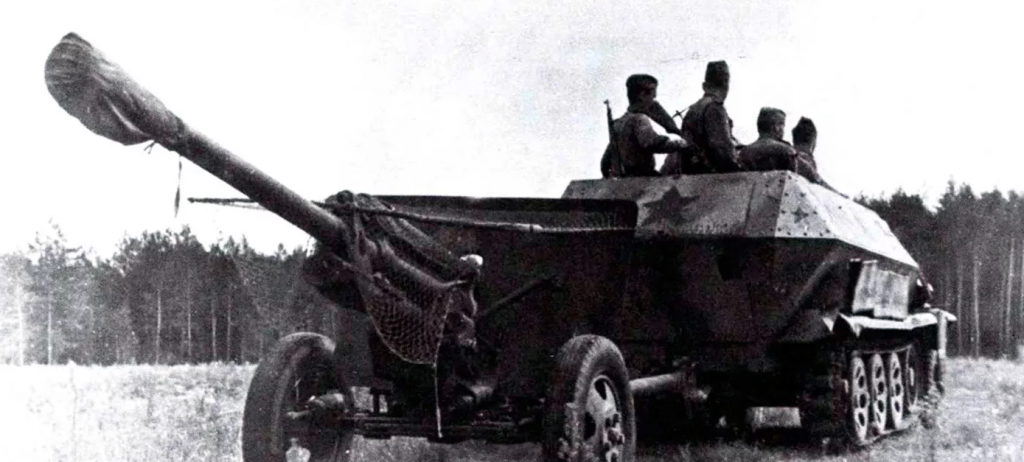
Description of construction
ZiS-3 – a gun of a modern design for that time. The barrel of the gun is a monoblock, with a breech and a muzzle brake (absorbing about 30% of the recoil energy). The shutter is vertical wedge, semi-automatic. Semi-automatic shutter of mechanical (copy) type. The descent is push-button or lever (on implements of various production series). The barrel resource for the guns of the first series is 5,000 rounds, for most of the guns – 2,000 rounds. When fired, the recoil devices roll back with the barrel; they consist of a hydraulic recoil brake and a hydropneumatic knurler. The rollback is permanent. The lifting mechanism has two sectors. Rotary screw type. The handles of the lifting and turning mechanisms are located to the left of the barrel, which greatly facilitated the gunner’s work when firing at moving targets. Spring balancing mechanism,pulling type, consists of two columns. The combat axis is straight. The gun is sprung, the springs are in the column. The wheels are metal, with rubber tires, close to those from the GAZ-AA car (with a different hub shape). To protect the crew, the gun had a 5 mm thick shield.
The gun is equipped with a panoramic sight PG-1. The panorama Site is used for precise aiming of the gun in the horizontal and vertical planes. In appearance, the panorama is a bent optical tube, in which a rotary head, a fixed body and a hook are distinguished.
When firing at night, the “Luch-2” or “Luch-2m” device is used to illuminate the panorama scales, panorama crosshairs, levels and the remote drum of sighting devices, scales necessary for the gun calculation.
To move with horse-drawn traction, the ZiS-3 is equipped with a unified front end mod. 1942 for regimental and divisional guns.
Combat use
Control elements
According to the service manual, the ZiS-3 is designed to solve the following combat missions:
- Destruction of enemy manpower
- Suppression and destruction of fire weapons of enemy infantry and his artillery
- Destruction of tanks and other motorized means of the enemy
- Destruction of wire fences
- Destruction of embrasures of pillboxes
It is interesting to note that in the German troops the Soviet divisions were called “ratsh-boom” – the sound of a projectile flying at supersonic speed was heard a little earlier than the sound of a shot impact. In 1943, this weapon became the main gun in divisional cannon artillery, as well as in anti-tank destroyer regiments., which had 76-mm guns on the staff. In the Battle of Kursk, the ZiS-3, along with 45 mm anti-tank guns and 122 mm M-30 howitzers, formed the backbone of Soviet artillery. At the same time, the inadequacy of the armor-piercing action of the guns against new German tanks and self-propelled guns was manifested, to some extent mitigated by the introduction of sub-caliber shells into the ammunition load, and from the end of 1944 – and cumulative shells. Later, until the end of the war, the ZiS-3 firmly retained the status of the main divisional gun, and since 1944 – due to the slowdown in the production of 45-mm cannons and the lack of 57-mm ZiS-2 cannons – this weapon de facto became the main anti-tank gun. Red Army. The captured cannons were also used by German and Finnish troops. In addition, the ZiS-3 was actively used by Soviet troops during the war with Japan. Used in the Yugoslav wars of 1991-2001,including on the armored train “Krajina Express” of the army of Serbian Krajina (1991-1995). As of 2017, it is used in hostilities in eastern Ukraine, as well as in Syria.
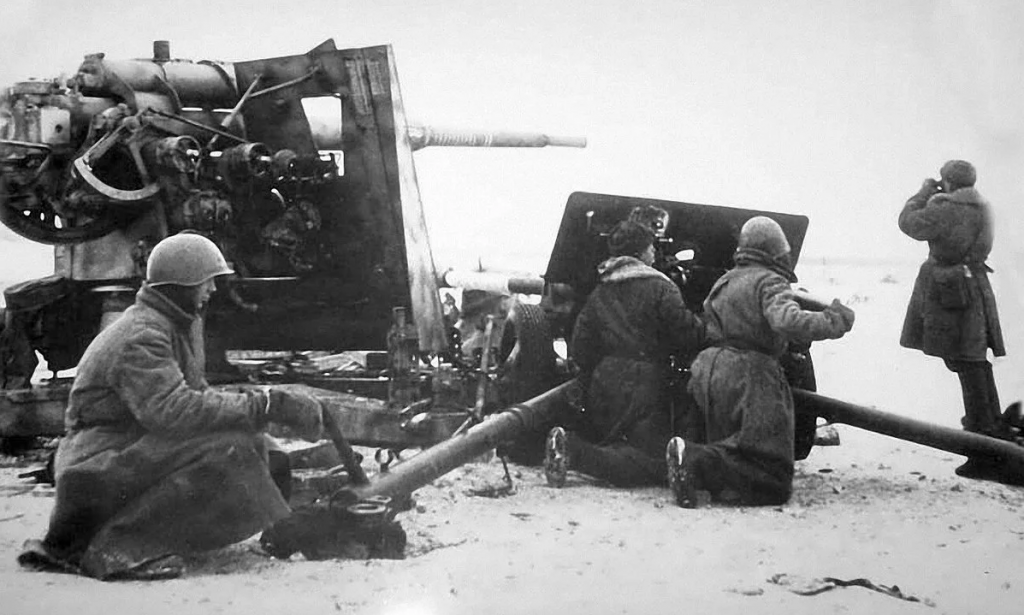
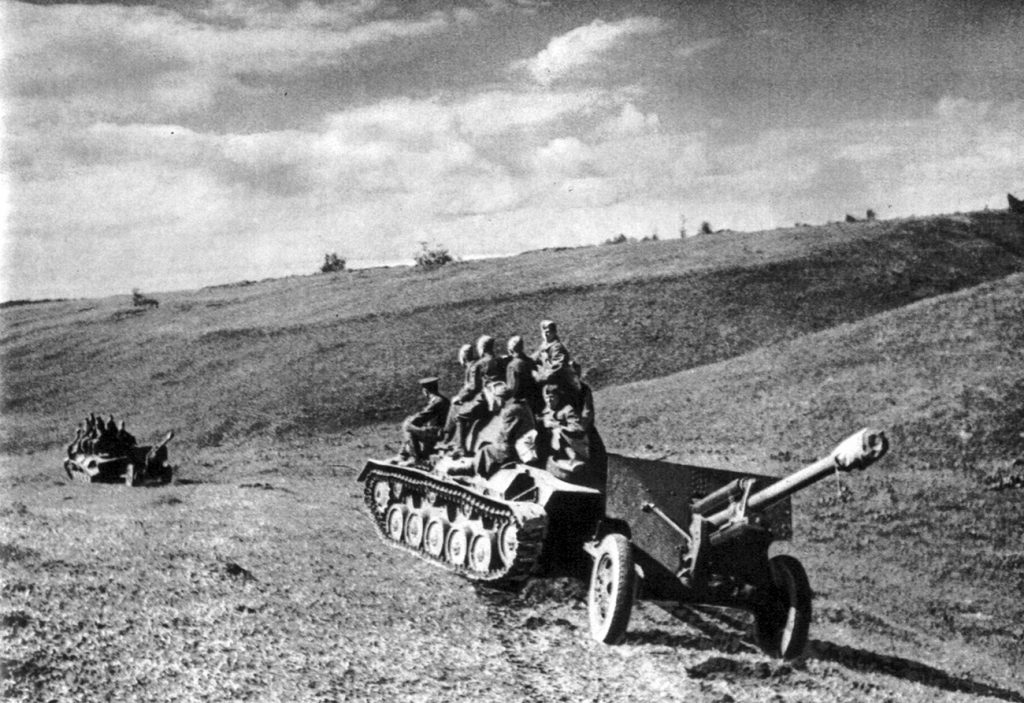
Ammunition characteristics and properties
The ZiS-3 fires a full range of 76mm cannon shells, including a variety of old Russian and imported rounds. The gun can also use unitary rounds for the 76-mm regimental cannon mod. 1927 with a lower propellant charge.
The 53-OF-350 steel high-explosive fragmentation grenade, when the fuse is set to the fragmentation action, at its rupture creates about 870 lethal fragments, the effective radius of destruction of manpower is about 15 m (data obtained according to the Soviet measurement method of the mid-20th century) When the fuse is installed on a high-explosive action, a grenade at a distance of 7.5 km is capable of breaking through a brick wall 75 cm thick or an earth embankment 2 m thick.
The 53-BR-354P APCR projectile penetrates 105 mm armor at a distance of 300 m, and 90 mm armor at a distance of 500 m. First of all, sub-caliber shells entered the anti-tank fighter units.
The 53-BP-350M cumulative projectile penetrates armor up to 75-90 mm thick at an angle of 45 °. The effective range of fire at a moving tank is up to 400 m. Such shells have been transferred to the troops since the end of 1944, after the fuse was modified, excluding its premature firing in the gun barrel when fired.
Project evaluation
The relatively small mass of the weapon allows it to be rolled.
76-mm divisional gun mod. 1942, at the time of adoption, fully met all the requirements for mobility, firepower, unpretentiousness in daily operation and manufacturability of production.
Mobility
The presence of cushioning made it possible to tow the gun with the most common in the Red Army trucks of the ZiS-5, GAZ-AA or GAZ-MM types. Also, the cannon could be towed by significantly less powerful light four-wheeled all-wheel drive vehicles Dodge WC (better known in the USSR as “Dodge 3/4″), which were a regular means of thrust in anti-tank fighter units. The designers have not forgotten the horse traction, for this the gun is equipped with a front end. The relatively small mass of the gun allows it to be rolled onto the battlefield only by the crew and to accompany the supported infantry with ” fire and wheels.”. Although this use is more typical of significantly lighter regimental guns of the same caliber, the ZiS-3 also more than once performed the function of directly supporting the advancing rifle units. In this regard, it looked clearly preferable to its heavier predecessors, the F-22 and USV. As a result, high mobility characteristics made it possible to use the gun in a very wide range of road and climatic conditions, even in conditions of insufficient motorization of the Red Army.
Firepower
Anti-personnel capabilities
Against openly located enemy personnel, the effect of 76-mm fragmentation and shrapnel shells was at the level or in some cases even exceeded the similar parameter of foreign guns of calibers 75 and 76.2 mm. However, the high-explosive action against field fortifications of any weapon of these calibers, including the ZiS-3, is not enough – a small amount of explosive in a 75- or 76-mm projectile affected, but for most massive fortifications and other targets on the battlefield, the ZiS-3 was effective. On the other hand, in the presence of howitzer divisions with 122-mm howitzers in the organizational and staff structure of a rifle, motorized or tank division, this deficiency at the unit level did not play a leading role.
Another frequently mentioned drawback of 76 mm guns is a small explosion cloud of a high-explosive or shrapnel projectile, which makes it extremely difficult to observe, and, consequently, to correct fire at a distance close to the maximum range. However, in most cases, divisional cannon artillery fired at distances of the order of 3-5 km, where the negative influence of this circumstance was no longer among the decisive ones.
Anti-tank capabilities
In terms of armor-piercing action, until the beginning of 1943, the ZiS-3 was capable of penetrating virtually any sample of German armored vehicles in the front at a range of up to 500-700 meters, with rare exceptions (for example, the StuG III Ausf F assault gun with 80-mm frontal armor); but with the massive appearance in 1943 of new models of German tanks and self-propelled artillery installations, the armor penetration of the ZiS-3 became insufficient. In particular, 80-mm armor with a low probability (below 50%) could be penetrated only at distances less than 300 m, and 100-mm armor could not be penetrated at all. Therefore, as of 1943, the booking of the heavy tank PzKpfW VI “Tiger”was invulnerable to the ZiS-3 in the frontal projection and weakly vulnerable at distances closer than 300 m in the side projection. The new German tank PzKpfW V “Panther” and the upgraded PzKpfW IV Ausf H and PzKpfW III Ausf M or N are also weakly vulnerable in the frontal projection for the ZiS-3 ; however, all these vehicles were confidently hit from the ZiS-3. The introduction of sub-caliber (since 1943) and cumulative (since the end of 1944) shells improved the anti-tank capabilities of the ZiS-3, allowing it to confidently hit vertical 80-mm armor at distances closer than 500 m, but the 100-mm vertical armor remained unbearable for it…
The relative weakness of the anti-tank capabilities of the ZiS-3 was realized by the Soviet military leadership, however, until the end of the war, it was not possible to replace the ZiS-3 in the anti-tank subunits: for example, the 57-mm anti-tank guns ZiS-2 in 1943-1944 were produced in the amount of 4375 pieces.., and ZiS-3 for the same period – in the amount of 30,053 pieces, of which about half were sent to anti-tank fighter units. The powerful 100-mm BS-3 field guns reached the troops only at the end of 1944 and in small numbers.
The insufficient armor penetration of the ZiS-3 guns was partially compensated by the tactics of use, focused on the defeat of the vulnerable spots of armored vehicles. In addition, against most samples of German armored vehicles, the armor penetration of the ZiS-3 remained adequate until the end of the war.
Reliability and manufacturability
The main trump cards of the ZiS-3 in comparison with analogues are the extreme simplicity in operation and the very high manufacturability of its production. For the conditions that existed in the USSR during the war, this was the most important advantage. The quality of training of personnel of divisional-level artillery units was most often low, in the conditions of extremely accelerated training in training units, the ability of the gun to withstand the lack of proper maintenance due to the low technical qualifications of the calculations became a decisive argument in its favor. The technical solutions applied by V.G.Grabin on this gun made it possible to produce the ZiS-3 with the conveyor method using even low-skilled labor in the absence of high-quality materials, using their cheap substitutes without a critical loss of combat and operational properties. This made it possible to saturate the troops in the shortest possible time, make up for the losses of the material part of the Soviet artillery and restore its combat effectiveness after heavy battles with heavy losses, such as the Battle of Kursk.
Compared to the German anti-tank gun ZiS-3, due to a less durable barrel group, a lower propellant charge and a poorer quality of projectiles, it significantly loses in armor penetration, but due to the lower recoil and a different design of the openers, the Soviet gun has one serious advantage in anti-tank use: it does not burrow into the ground when shooting. Pak 40, when firing, buries itself in the ground so strongly that it is impossible to turn it in a given direction by the if necessary – pulling out a gun stuck in the ground can only be done with a powerful tractor… With a flank attack by the enemy, this circumstance became deadly. The smaller mass of the ZiS-3 also favored wheel support for its infantry, which is much more difficult for the Pak 40. A number of sources also note a slightly better high-explosive fragmentation effect of 76-mm ZiS-3 shells compared to 75-mm German shells. Almost the same can be said about the Pak 40’s equal power and even heavier 76mm American M5 anti-tank gun. It is noteworthy here that this gun, despite the highest armor-piercing capabilities among other American towed guns, was unsatisfactorily regarded by representatives of the US Army due to the impossibility of rolling it over by the crew. The British 87.6-mm howitzer-gun QF 25 pounder, although it was used at the divisional level and has a relatively close caliber to 76.2 mm,already belongs to a somewhat different class of guns, and therefore its direct comparison with the ZiS-3 is illegal. Nevertheless, high-quality materials and highly qualified personnel with an excellent culture of the production of guns and ammunition allowed the British to create an outstanding weapon with the best high-explosive fragmentation effect compared to the ZiS-3 and almost equal armor-piercing.
In comparison with similar in caliber and still quite numerous modernized guns of the First World War (various Soviet, Polish, French and Finnish improvements to Canon de 75 Modèle 1897 or 76-mm divisional gun model 1902), the ZiS-3 is far ahead in most indicators.
Summing up, we can say that the 76-mm divisional gun mod. 1942 (ZiS-3) was a model of weapons, in terms of its characteristics at the level of the best world models, and in terms of manufacturability and reliability – ideally suited to the conditions of operation and production of the USSR during wartime. Although its combat capabilities, starting from 1943, did not fully meet the requirements of the time, it allowed the Soviet artillerymen to gain significant experience, which was useful already in the post-war period when mastering new weapons, more powerful, but also more demanding in terms of the qualifications of service personnel.
